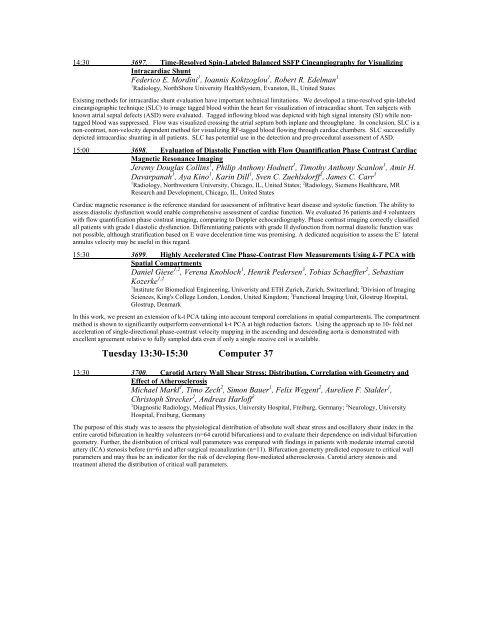ELECTRONIC POSTER - ismrm
ELECTRONIC POSTER - ismrm
ELECTRONIC POSTER - ismrm
You also want an ePaper? Increase the reach of your titles
YUMPU automatically turns print PDFs into web optimized ePapers that Google loves.
14:30 3697. Time-Resolved Spin-Labeled Balanced SSFP Cineangiography for Visualizing<br />
Intracardiac Shunt<br />
Federico E. Mordini 1 , Ioannis Koktzoglou 1 , Robert R. Edelman 1<br />
1 Radiology, NorthShore University HealthSystem, Evanston, IL, United States<br />
Existing methods for intracardiac shunt evaluation have important technical limitations. We developed a time-resolved spin-labeled<br />
cineangiographic technique (SLC) to image tagged blood within the heart for visualization of intracardiac shunt. Ten subjects with<br />
known atrial septal defects (ASD) were evaluated. Tagged inflowing blood was depicted with high signal intensity (SI) while nontagged<br />
blood was suppressed. Flow was visualized crossing the atrial septum both inplane and throughplane. In conclusion, SLC is a<br />
non-contrast, non-velocity dependent method for visualizing RF-tagged blood flowing through cardiac chambers. SLC successfully<br />
depicted intracardiac shunting in all patients. SLC has potential use in the detection and pre-procedural assessment of ASD.<br />
15:00 3698. Evaluation of Diastolic Function with Flow Quantification Phase Contrast Cardiac<br />
Magnetic Resonance Imaging<br />
Jeremy Douglas Collins 1 , Philip Anthony Hodnett 1 , Timothy Anthony Scanlon 1 , Amir H.<br />
Davarpanah 1 , Aya Kino 1 , Karin Dill 1 , Sven C. Zuehlsdorff 2 , James C. Carr 1<br />
1 Radiology, Northwestern University, Chicago, IL, United States; 2 Radiology, Siemens Healthcare, MR<br />
Research and Development, Chicago, IL, United States<br />
Cardiac magnetic resonance is the reference standard for assessment of infiltrative heart disease and systolic function. The ability to<br />
assess diastolic dysfunction would enable comprehensive assessment of cardiac function. We evaluated 36 patients and 4 volunteers<br />
with flow quantification phase contrast imaging, comparing to Doppler echocardiography. Phase contrast imaging correctly classified<br />
all patients with grade I diastolic dysfunction. Differentiating patients with grade II dysfunction from normal diastolic function was<br />
not possible, although stratification based on E wave deceleration time was promising. A dedicated acquisition to assess the E’ lateral<br />
annulus velocity may be useful in this regard.<br />
15:30 3699. Highly Accelerated Cine Phase-Contrast Flow Measurements Using k-T PCA with<br />
Spatial Compartments<br />
Daniel Giese 1,2 , Verena Knobloch 1 , Henrik Pedersen 3 , Tobias Schaeffter 2 , Sebastian<br />
Kozerke 1,2<br />
1 Institute for Biomedical Engineering, Univeristy and ETH Zurich, Zurich, Switzerland; 2 Division of Imaging<br />
Sciences, King's College London, London, United Kingdom; 3 Functional Imaging Unit, Glostrup Hospital,<br />
Glostrup, Denmark<br />
In this work, we present an extension of k-t PCA taking into account temporal correlations in spatial compartments. The compartment<br />
method is shown to significantly outperform conventional k-t PCA at high reduction factors. Using the approach up to 10- fold net<br />
acceleration of single-directional phase-contrast velocity mapping in the ascending and descending aorta is demonstrated with<br />
excellent agreement relative to fully sampled data even if only a single receive coil is available.<br />
Tuesday 13:30-15:30 Computer 37<br />
13:30 3700. Carotid Artery Wall Shear Stress: Distribution, Correlation with Geometry and<br />
Effect of Atherosclerosis<br />
Michael Markl 1 , Timo Zech 2 , Simon Bauer 1 , Felix Wegent 2 , Aurelien F. Stalder 1 ,<br />
Christoph Strecker 2 , Andreas Harloff 2<br />
1 Diagnostic Radiology, Medical Physics, University Hospital, Freiburg, Germany; 2 Neurology, University<br />
Hospital, Freiburg, Germany<br />
The purpose of this study was to assess the physiological distribution of absolute wall shear stress and oscillatory shear index in the<br />
entire carotid bifurcation in healthy volunteers (n=64 carotid bifurcations) and to evaluate their dependence on individual bifurcation<br />
geometry. Further, the distribution of critical wall parameters was compared with findings in patients with moderate internal carotid<br />
artery (ICA) stenosis before (n=6) and after surgical recanalization (n=11). Bifurcation geometry predicted exposure to critical wall<br />
parameters and may thus be an indicator for the risk of developing flow-mediated atherosclerosis. Carotid artery stenosis and<br />
treatment altered the distribution of critical wall parameters.
















